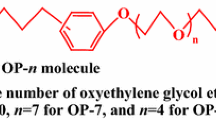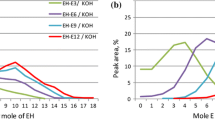Abstract
Phosphate surfactants containing ether and hydroxyl groups were prepared by a simple reaction between the corresponding epoxide and the diethyl phosphate. The relationships between the structure and colloidal properties were evaluated in terms of the critical micelle concentration (CMC), γCMC, foaming ability, and water absorbing and holding abilities. Based on these results, it was concluded that the ether and hydroxy groups synergistically worked together to decrease the CMC and increase the foaming ability. The degree of neutralization remarkably affected the colloidal properties. The highly neutralized states showed a more positive effect on water holding power but an opposite effect on the foaming ability.










Similar content being viewed by others
References
Jungermann E, Silberman HC (1976) Phosphorous-containing anionic surfactants. In: Linfield WM (ed) Anionic surfactants Part II. Marcel Dekker, New York, pp 495–580 Chap 15
Tracy DJ, Reierson RL (2002) Commercial synthesis of monoalkyl phosphates. J Surfactants Deterg 5:169–172
Sala M, Kolar J, Strlic M, Kocevar M (2006) Synthesis of myo-inositol 1, 2, 3-tris- and 1, 2, 3, 5-tetrakis (dihydrogen phosphate)s as a tool for the inhibition of iron-gall-ink corrosion. Carbohydrate Res 341:897–902
Samui AB, Phadnis SM (2005) Polyaniline-dioctyl phosphate salt for corrosion protection of iron. Prog Org Coat 54:263–267
Park HS, Kim SJ, Rhee HW (1997) Synthesis and properties of water-soluble polyamine phosphate type durable antistatic agent. Sen-i Gakkaishi 53:249–257
Polowinska A, Szosland L, Jantas R (1987) New phosphoric derivatives of poly(ethyleneglycol)s as antistatic agents for man-made fibers. Acta Polym 38:125–131
Hellsten M, Karlsson G, Emanuelsson J (1971) Alkyl phosphates as inhibitors for metal corrosion in detergents containing chelating agents. Tenside Deterg 8:237–247
Plass J, Emeis D, Blumich B (2001) P-31 nuclear magnetic resonance studies on alkyl phosphate emulsifiers in cosmetic oil-in-water emulsions. J Surf Deterg 4:379–384
Riddle BL, Kipp EM (1991) Friction and wear properties of PEG esters in the presence of a complex phosphate ester. Lubr Eng 47:991–996
Yuan ZW, Hao JC, Hoffmann H (2006) A promising system of mixed single- and double-short-tailed PEO ether phosphate esters: phase behavior and vesicle formation. J Colloid Interface Sci 302:673–681
Nan YQ, Hao LS, Liu HL (2006) The influence of sodium phosphate on extraction phenomena of aqueous two-phase cationic/anionic surfactant systems. J Dispers Sci Technol 27:419–425
Zhu YP, Masuyama A, Okahara M (1991) J Am Oil Chem Soc 68:268–271
Imokawa G, Tsutsumi H, Kurosaki T (1978) Surface activity and cutaneous effects of monoalkyl phosphate surfactants. J Am Oil Chem Soc 55:839–843
Imokawa K (1979) Study on skin-irritating and biological properties of monoalkyl phosphate anionic surfactants. J Am Oil Chem Soc 56:604–609
Tsubone K, Uchida N, Mimura K (1990) New amphoteric surfactants containing a phosphoric acid group:1. Synthesis and physicochemical properties of sodium 2-(N-2-hydroxyalkyl-N-methylamino)ethyl hydrogen phosphate. J Am Oil Chem Soc 67:451–454
Sandler SR, KaroW (1968) In: Organic functional group preparations, Chap 5, Ethers and oxides, Academic Press, New York, p 109
Abe A, Asakura K, Osanai S (2004) Synthesis and characterization of novel amphiphiles containing amino acid and carbohydrate. J Surf Deterg 7:297–303
Dahanayake M, Cohen AW, Rosen MJ (1986) Relationship of structure to properties of surfactants13. Surface and thermodynamic properties of oxyethylenated sulfates and sulfonates. J Phys Chem 90:2413–2418
Lange H, Schwuger MJ (1980) Grenzflaecheneigenschaften von Alkylsulfaten. Colloid Polym Sci 258:1264–1270
Aratono M, Ikeda N (1997) Adsorption of surfactants at a gas–liquid interface. In Surfactant Science Series 70, Chap 2, Marcel Dekker, NY, pp 116–117
Deguchi K, Osanai S, Umezawa S (2001) Synthesis and physicochemical properties of dipeptide type surfactants I, N-dedecanoylglutamyl-glutamic acid and glutamylaspartic acid. J Oleo Sci 50:763–772
Author information
Authors and Affiliations
Corresponding author
About this article
Cite this article
Osanai, S., Yamada, G., Hidano, R. et al. Preparation and Properties of Phosphate Surfactants Containing Ether and Hydroxy Groups. J Surfact Deterg 13, 41–49 (2010). https://doi.org/10.1007/s11743-009-1137-3
Received:
Accepted:
Published:
Issue Date:
DOI: https://doi.org/10.1007/s11743-009-1137-3




